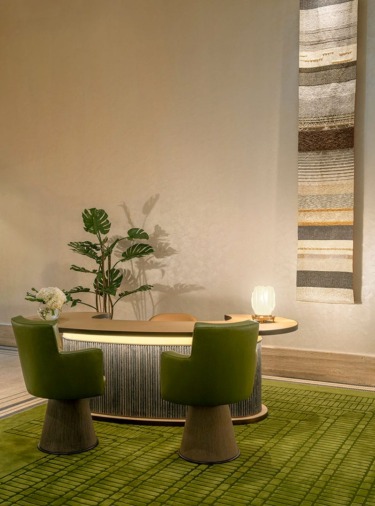Step Inside the Reimagined Hotel Anantara Plaza in Nice
David Collins Studio transforms a 19th-century architectural gem with a flurry of artistic details

Nice sounds so chic. Its famous Promenade des Anglais runs along the sparkling Mediterranean sea, and a beach serviced by tens of clubs where navy and white striped loungers and umbrellas are lined up on the sand, their shaded dining spots slotted beneath the corniche. High on a cliff is the fantasy confection that is the Chateau de l’Anglais, with its crazy mix of gothic and Hindu architecture. And next to that is, I am told, a house owned by Elton John.
And yet, sitting as it does between the extreme glitz of Monte Carlo and the fabulousness of Cannes, Nice is a bit of a Cinderella. She really could be a bit chicer, but like Cinderella, it seems that she might just be on her way to the ball. Its public parks and gardens are being carefully renewed, the dazzling hotel Negresco has had a fresh lick of paint.

But if anything symbolizes an upmarket move, its that the public parts of the newly reopened Anantara Plaza Nice Hotel have been designed with customary élan by the London-based David Collins Studio. “We know this part of the world really well,” says Chief Creative Officer Simon Rawlings. “We did the Le Bar Américain at the Hotel de Paris in Monte Carlo, and we’re working on [another project] there. Nice, though, is having a real resurgence. And it’s very laidback. I love it.”

The Plaza had been something of a landmark. “Aristocrats came here in the winter in the 19th century. Queen Victoria stayed,” says Jean-Paul Gomis, the local architect who worked on the building’s most recent restructuring. By 1900 it was renamed the Plaza, but known colloquially as the ‘Salon d’Europe’ or Europe’s drawing room. “The original building from 1840 was called the Hotel de France and had a wonderful neo-classical façade. Later, it was given a Belle Epoque twist when architect Charles Dalmas united two buildings in 1913. By the time I got to it, it was in a really bad state.” Gomis has painstakingly restored its exterior and replaced all damaged ironwork.
Rawlings, with his design director Lewis Taylor, decided to take inspiration from both the location and the early twentieth century period of French design. “We were thinking particularly about designers like Jean-Michel Franck, whose focus was on purity of form, and the beauty of materials,” says Rawlings. “And we went for bleached out colors, bold but muted. Most important was to create a calming and almost residential feel. This hotel has been around for a long time. We didn’t want it to be trendy or fashionable.” Walls are finished in pale stucco, floors are a peachy travertine.


Visitors enter through a black-and-white tiled hallway and into a minimalist reception hall, where hand-woven tapestries by the Northern Irish artist Jude Cassidy are hung from bespoke brass chains by Lobmeyr. Next is the oval lobby lounge, called Les Colonnades, with a continuous oval banquette upholstered in a leaf-green closely shaved mohair. A cornice made of circular plaster discs circumscribes the room; paneling is in a fresh light oak. “It was a project constructed around textures. I wanted it to be very natural, with a sort of Hermès sensibility,” says Rawlings. (Hermès just happens to be next door.) “Expensive, but not flashy.”

For all it is reassuring, it is not predictable. Two large scale paintings have been created for the space by the Cornish artist Saul Cathcart, one inspired by the mountains behind the city, the other by the Mediterranean Sea. “I invited him to come to Nice and stand on the roof of the building, and that’s what you see,” says Rawlings. “I love the intensity of his colors, and the way he uses fluorescents against moody greys.”
On the newly extended rooftop, which is the hotel’s other public part, the studio has created a restaurant and outdoor bar terrace, punctuated with devilish details. Look closely and you’ll notice the table tops are lined with a mother of pearl paper by Callidus Guild, shimmering beneath the glass. A custom “louvred” chandelier in decorative mesh by Sophie Mallebranch hangs in the centre of the restaurant. “It’s inspired by boat sails,” says Rawlings. Glass screens in three different types of textured glass bring a Deco feel, while fancy shell lights perhaps roll back to the decade before.

I would recommend a visit soon. The restaurant is currently run by Portuguese chef Olivier da Costa and truly excellent (who knew beetroot carpaccio could be this good) but it has already been overrun by a rampant infestation of artificial wisteria which David Collins Studio did not specify to hang from its ceiling. One hopes that the rest of the subtley put-together design will not get swamped by add-ons. After all, as Rawlings says, “I think the city of Nice is going through an evolution, and the new visitor will want quality and good taste.”